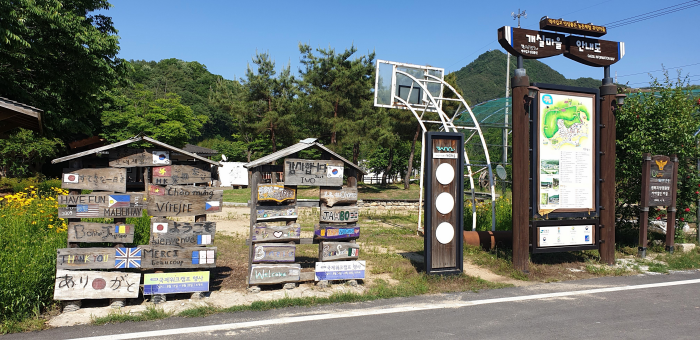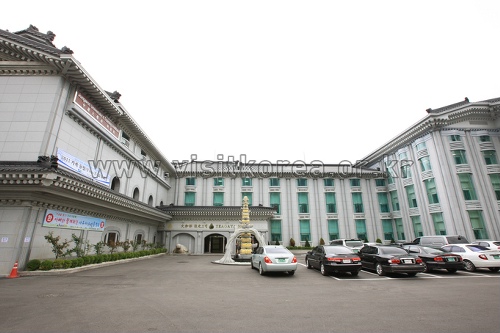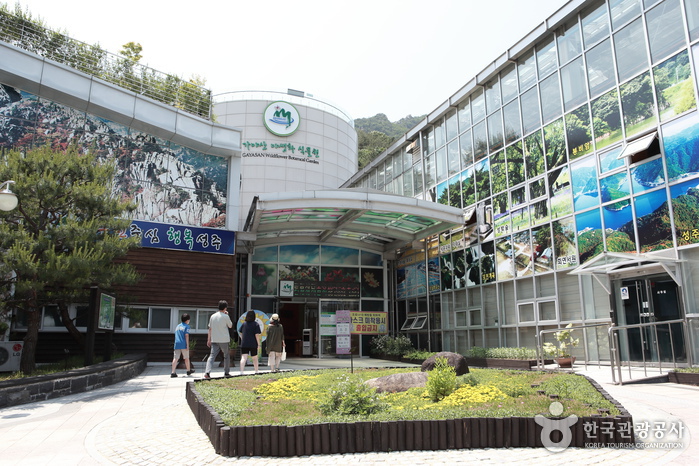The House of Soccer kkumnamu (Future Soccer Player) [Korea Quality] / 축구꿈나무집 [한국관광 품질인증]
6.6Km 2020-09-09
32, Gaesil 1-gil, Ssangnim-myeon, Goryeong-gun, Gyeongsangbuk-do
+82-54-956-4022 / +82-10-3207-4022
The House of Soccer kkumnamu (The House of Future Soccer Player) of the Gaesil Village Farming Association Corporation is a hanok-style accommodation complete with a grassy field and a courtyard filled with well-kept flowerpots, creating a serene atmosphere around the hanok. The house has two Korean-style rooms with a capacity of two to four people. The Nansil room also has a kitchen. This cozy hanok is equipped with modern facilities for guests’ comfort and convenience, as well as the full range of amenities including TV, fridge, air-conditioner, toiletries, and table. Guests are permitted to hold a BBQ outside provided that they supply the charcoal themselves.
Known as the village of the Seonsan Kim clan, Gaesil Village was founded by the descendants of Kim Jong-jik (pen-name: Jeompiljae, 1431-1492), a leading Korean Neo-Confucian scholar of the early Joseon period who died during the Literati Purge of 1498. The head house of Kim Jong-jik (Provincial Folk Material No. 62) and Doyeonjae (Provincial Cultural Heritage Material No. 111), the old village school, are also situated in the village. In addition, the nearby Daegaya Museum displays the writing accessories of Kim Jong-jik (Provincial Tangible Cultural Heritage No. 209).
The village is also known as Gaehwasil, meaning “a beautiful valley with blooming flowers” as it is surrounded by a flower-covered mountain called Mt. Hwagaesan, a 350-year-old bamboo forest, and Jeopmubong Peak, which is said to resemble a fluttering butterfly. Over 80% of the village houses are traditional hanok buildings nestled amid a cozy environment.
During the Campaign to Create Beautiful Communities conducted in 2001 and the Farm Experience Village Development Project in 2005, the village’s hanok were renovated or entirely rebuilt, earthen-stone walls were built, walking paths created, and refined landscaping works carried out, establishing the village in its current form. Furthermore, a village shelter, experience center, Internet café, and other facilities were built for the convenience of residents and visitors alike. In recognition of the villager’ efforts to revitalize their community, Gaesil was awarded the presidential citation at the Korea Rural Village Awards in 2011.
Designated as a NongHyup’s Farm Stay Village in 2003, Gaesil operates a wide variety of hands-on experience programs relating to nature, agriculture, and local traditions, such as collecting sweet potatoes and rice planting; Korean traditional etiquette and tea ceremony; kite making and straw handicrafts; traditional food experiences such as yeot (Korean hard taffy) and yugwa (deep-fried sweet rice cakes); traditional games such as riding on a swing and neolttwigi (Korean see-saw); as well as loach fishing, ice sledding and so on. Gaesil Village, a representative farm stay village that “blooms” in every season, attracts around 50-60,000 visitors every year.
Aldea Gaesil (개실마을)
6.6Km 2022-05-10
Gaesil 1-gil 29, Ssangnim-myeon, Goryeong-gun, Gyeongsangbuk-do
La aldea Gaesil está situada en Gyeongsangbuk-do, enfrente del pico Jeopmubong, con forma de mariposa. Hay muchas leyendas sobre protocolo coreano que proceden de este lugar. Una de ellas hace mención a una familia en la que los hijos han apoyado siempre a sus padres durante 5 generaciones. Cuando la madre enfermó, un faisán voló hasta la cocina. En invierno, una carpa saltó del estanque. Por esta leyenda, el pueblo también ha sido llamado "Ingeobaemi". Al contrario que otros pueblos, los descendientes de la aldea Gaesil han mantenido sus tradiciones, como el protocolo y la devoción a los padres, que se puede experimentar durante la estancia en la aldea.
Seokjeongdaek House [Korea Quality] / 개실마을영농조합법인 석정댁 [한국관광 품질인증]
6.6Km 2020-09-09
6, Gaesil 2-gil, Ssangnim-myeon, Goryeong-gun, Gyeongsangbuk-do
+82-54-956-4022 / +82-10-3207-4022
The Seokjeongdaek House in the village of Gaesil is rented out in its entirety to allow guests to enjoy their stay completely undisturbed. Upon entering the large gate situated between the low walls, guests will discover a spacious courtyard and a fine wooden hanok. This large hanok consists of two rooms, a living room and a kitchen, and can accommodate 8 to 10 people. Each room is equipped with various amenities including TV, fridge, Internet, and air-conditioning. Guests can cook using the cooking equipment in the kitchen and hold a BBQ party in the courtyard. Known as the village of the Seonsan Kim clan, Gaesil Village was founded by the descendants of Kim Jong-jik (pen-name: Jeompiljae, 1431-1492), a leading Korean Neo-Confucian scholar of the early Joseon period who died during the Literati Purge of 1498. The head house of Kim Jong-jik (Provincial Folk Material No. 62) and Doyeonjae (Provincial Cultural Heritage Material No. 111), the old village school, are also situated in the village. In addition, the nearby Daegaya Museum displays the writing accessories of Kim Jong-jik (Provincial Tangible Cultural Heritage No. 209). The village is also known as Gaehwasil, meaning “a beautiful valley with blooming flowers” as it is surrounded by a flower-covered mountain called Mt. Hwagaesan, a 350-year-old bamboo forest, and Jeopmubong Peak, which is said to resemble a fluttering butterfly. Over 80% of the village houses are traditional hanok buildings nestled amid a cozy environment. During the Campaign to Create Beautiful Communities conducted in 2001 and the Farm Experience Village Development Project in 2005, the village’s hanok were renovated or entirely rebuilt, earthen-stone walls were built, walking paths created, and refined landscaping works carried out, establishing the village in its current form. Furthermore, a village shelter, experience center, Internet café, and other facilities were built for the convenience of residents and visitors alike. In recognition of the villager’ efforts to revitalize their community, Gaesil was awarded the presidential citation at the Korea Rural Village Awards in 2011. Designated as a NongHyup’s Farm Stay Village in 2003, Gaesil operates a wide variety of hands-on experience programs relating to nature, agriculture, and local traditions, such as collecting sweet potatoes and rice planting; Korean traditional etiquette and tea ceremony; kite making and straw handicrafts; traditional food experiences such as yeot (Korean hard taffy) and yugwa (deep-fried sweet rice cakes); traditional games such as riding on a swing and neolttwigi (Korean see-saw); as well as loach fishing, ice sledding and so on. Gaesil Village, a representative farm stay village that “blooms” in every season, attracts around 50-60,000 visitors every year.
Hadongdaek House [Korea Quality] / 하동댁 [한국관광 품질인증]
6.7Km 2021-04-05
45, Gaesil 2-gil, Ssangnim-myeon, Goryeong-gun, Gyeongsangbuk-do
+82-54-956-4022, +82-10-3207-4022
The village of Gaesil is known as the village of the Seonsan Kim clan. It was established by the descendants of Kim Jong-jik (pen-name: Jeompiljae, 1431-1492), a leading Korean Neo-Confucian scholar and the founder of the Yeongnam Sarim faction during the mid-Joseon period. Boasting over 300 years of tradition, the village is home to sixty households as well as a number of cultural heritages including the head house of Kim Jong-jik (Provincial Folk Material No. 62), Doyeonjae (Provincial Cultural Heritage material No. 111), which is the old village school, and the printing woodblocks for a collection of literary works including Yijonrok (a book about the life and achievements of Kim’s father Kim Suk-ja) written by Kim Jong-jik (Provincial Tangible Cultural Heritage No. 175).
The residents have renovated the village’s earthen walls and hanok houses into a current hanok village, and also run various hands-on experience programs including a hanok stay, a farm product cultivation program, and traditional etiquette and games, thereby offering urban travelers an opportunity to experience a truly rural lifestyle. The Hadongdaek House has two traditional Korean-style guestrooms. The Maesil room is equipped with a kitchen and a bathroom, while guests who stay in the Juksil should use the communal bathroom and kitchen outside the room. The well-kept garden harmonizes perfectly with the cozy hanok.
Deokdongdaek House [Korea Quality] / 덕동댁 [한국관광 품질인증]
6.7Km 2020-09-09
39, Gaesil 2-gil, Ssangnim-myeon, Goryeong-gun, Gyeongsangbuk-do
+82-54-956-4022 / +82-10-3207-4022
The Deokdongdaek House of the Gaesil Village Farming Association Corporation is an elegant hanok building with a grassy courtyard and a charming atmosphere. This ‘一’-shaped hanok consists of two rooms – the Maesil Room for 2 to 3 people, and the Juksil Room for 3 to 5 people. Each room is decorated with refined hanji wallpaper (Hanji is a traditional Korean paper handmade from the mulberry tree) and equipped with a range of amenities including TV, fridge, air-conditioner, Internet, and toiletries. The Juksil Room is also equipped with cooking facilities, and guests can have a BBQ party in the large courtyard.
Known as the village of the Seonsan Kim clan, Gaesil Village was founded by the descendants of Kim Jong-jik (pen-name: Jeompiljae, 1431-1492), a leading Korean Neo-Confucian scholar of the early Joseon period who died during the Literati Purge of 1498. The head house of Kim Jong-jik (Provincial Folk Material No. 62) and Doyeonjae (Provincial Cultural Heritage Material No. 111), the old village school, are also situated in the village. In addition, the nearby Daegaya Museum displays the writing accessories of Kim Jong-jik (Provincial Tangible Cultural Heritage No. 209).
The village is also known as Gaehwasil, meaning “a beautiful valley with blooming flowers” as it is surrounded by a flower-covered mountain called Mt. Hwagaesan, a 350-year-old bamboo forest, and Jeopmubong Peak, which is said to resemble a fluttering butterfly. Over 80% of the village houses are traditional hanok buildings nestled amid a cozy environment.
During the Campaign to Create Beautiful Communities conducted in 2001 and the Farm Experience Village Development Project in 2005, the village’s hanok were renovated or entirely rebuilt, earthen-stone walls were built, walking paths created, and refined landscaping works carried out, establishing the village in its current form. Furthermore, a village shelter, experience center, Internet café, and other facilities were built for the convenience of residents and visitors alike. In recognition of the villager’ efforts to revitalize their community, Gaesil was awarded the presidential citation at the Korea Rural Village Awards in 2011.
Designated as a NongHyup’s Farm Stay Village in 2003, Gaesil operates a wide variety of hands-on experience programs relating to nature, agriculture, and local traditions, such as collecting sweet potatoes and rice planting; Korean traditional etiquette and tea ceremony; kite making and straw handicrafts; traditional food experiences such as yeot (Korean hard taffy) and yugwa (deep-fried sweet rice cakes); traditional games such as riding on a swing and neolttwigi (Korean see-saw); as well as loach fishing, ice sledding and so on. Gaesil Village, a representative farm stay village that “blooms” in every season, attracts around 50-60,000 visitors every year.
Academia Neoconfuciana Dodong Seowon (도동서원) [Patrimonio Cultural de la Humanidad de la Unesco]
10.5Km 2023-01-05
Gujiseo-ro 726, Guji-myeon, Dalseong-gun, Daegu
+82-53-688-3162
La Academia Neoconfuciana Dodong Seowon está situada en Daegu y es una de las cinco escuelas confucianas más grandes de Corea, junto con Byeongsan Seowon, Oksan Seowon, Sosu Seowon y Dosan Seowon. El instituto fue creado por estudiosos confucianos en 1568, al este del monte Biseulsan, fue destruido durante la invasión japonesa en 1592, y reconstruido en 1605, bajo el nombre de Borodong. Años después se le llamaría Dodong, que significa las enseñanzas (do) del confucianismo que viene del este (dong). Algunas partes que merece la pena visitar del instituto son la puerta de la tierra, una sala llamada Jungjeongdang, el pabellón Suwollu, y los árboles ginkgo de más de 400 años. Dentro de la sala Jungjeongdang hay una escultura con 4 cabezas de dragón, llamada Samuljan, que simboliza las enseñanzas de Confucio.
Sangbiwon[Korea Quality] / 생비원[한국관광 품질인증/Korea Quality]
11.3Km 2020-12-10
28, Nori 2-gil, Deokgok-myeon, Goryeong-gun, Gyeongsangbuk-do
+82-10-6732-4578, +82-54-954-1528
Saengbiwon is a traditional hanok pension located 400 m above sea level on Gayasan Mountain, Goryeong, North Gyeongsang Province. Its picturesque front garden, full of clay pots and wildflowers, and the dried persimmon hanging on the porch come fall give the pension a comfortable, idyllic atmosphere. Clear water from the Sangbiri Valley flow near the pension and a footpath along the reservoir offer great opportunities to enjoy the nature of Gayasan Mountain. Opening the window brings one face-to-face with the four seasons of the mountain, while the pavilion in the garden emanates a cool, slow-paced enjoyment of nature. All water used in the pension is drawn from a natural mineral spring 150 m below the land, giving the water a crisp and refreshing taste.
The seven rooms of the pension, including the Dongbaek, Maehwa, Mongnyeon, Moran, and Hwangtobang are furnished with red clay and Cheongsong hanji (Korean traditional paper) interior, giving them a characteristic hanok look. Wooden wardrobes and thick cotton quilts bring in mind the image of a grandmother’s warm house. Two of the rooms are heated with traditional gudeul floor heating, which is a blessing in the biting heat of winter. All rooms have access to Wi-Fi, equipped with modern bathrooms, electric kettle, pressure rice cooker, and simple cooking utensils. Only the Hwangtobang room allows cooking within the room, and guests in other rooms must use the communal kitchen and barbeque areas. There is also an annex, which hosts exclusively group visitors and can be used as a seminar room and a training site. .
Saengbiwon’s other pride is the traditional sauces, made in house for four generations. Visitors can reserve an elegant Korean breakfast, served in brass tableware, made with Saengbiwon’s handmade sauce from Korean soybeans. Saengbiwon also offers programs like sauce-making, Korean malt candy-making, tofu-making, Korean sweets-making, and tea ceremony.
Parque Nacional del Monte Gayasan (Sector de Baegun-dong) (가야산국립공원(백운동 지구))
13.4Km 2023-02-20
Baegun-ri, Suryun-myeon, Seongju-gun, Gyeongsangbuk-do
El monte Gayasan, en Gyeongsangbuk-do, fue designado como Parque Nacional en 1972. La cima Chilbulbong llega a los 1.433 metros. Hace límite con Seongju-gun, Hapcheon-gun y Geochang-gu. En particular, Suryun-myeon, en Seongju-gun, es famoso por su paisaje. Además, la belleza de la montaña, que se extiende desde Suryun-myeon hasta la montaña, destaca el esplendor y la grandeza de los acantilados escarpados de color carmesí. El recorrido también ofrece una vistas hermosas durante todo el tramo de senderos hasta llegar a las fascinantes cascadas.
En la zona Baegun-dong, se encontrará con el templo Beopjusa. Este templo fue construido durante el período de Silla y se dice que fue el mayor templo de su tiempo, con aproximadamente 100 recintos. Ahora, solo permanecen una estupa, pilares y soportes. El valle Yonggigol ofrece unos caminos donde poder disfrutar de las impresionantes vistas del monte Gayasan.
Gaya Hotel (가야호텔)
13.5Km 2025-01-02
52, Gayasansingmurwon-gil, Seongju-gun, Gyeongsangbuk-do
+82-54-931-3500
Gaya Hotel is located 560 meters above sea level on Gayasan Mountain in a pristine natural environment. The hotel also offers a sauna that uses natural mineral water. Near the hotel is the only Korean wild flower botanical garden.
Jardín Botánico de Plantas Silvestres de Gayasan (가야산 야생화식물원)
13.6Km 2022-08-03
Gayasansingmurwon-gil 49, Suryun-myeon, Seongju-gun, Gyeongsangbuk-do.
Establecido en junio de 2006, el Jardín Botánico de Plantas Silvestres de Gayasan es el primer jardín de plantas silvestres del país, con aproximadamente 400 especies distintas. El jardín exterior ofrece un magnífico paisaje del monte Gayasan, y tiene diferentes sectores: arbustos, jardín de crisantemos, jardín de plantas nativas de Gayasan, jardín educativo de plantas silvestres, etc. Por su parte, el invernadero está formado por árboles de temperaturas cálidas y plantas silvestres. Disfrute de la agradable fragancia de las flores durante todas las estaciones del año.
![The House of Soccer kkumnamu (Future Soccer Player) [Korea Quality] / 축구꿈나무집 [한국관광 품질인증]](http://tong.visitkorea.or.kr/cms/resource/77/2629377_image2_1.jpg)

![Seokjeongdaek House [Korea Quality] / 개실마을영농조합법인 석정댁 [한국관광 품질인증]](http://tong.visitkorea.or.kr/cms/resource/24/2573424_image2_1.jpg)
![Hadongdaek House [Korea Quality] / 하동댁 [한국관광 품질인증]](http://tong.visitkorea.or.kr/cms/resource/44/2556344_image2_1.jpg)
![Deokdongdaek House [Korea Quality] / 덕동댁 [한국관광 품질인증]](http://tong.visitkorea.or.kr/cms/resource/32/2573332_image2_1.jpg)

![Sangbiwon[Korea Quality] / 생비원[한국관광 품질인증/Korea Quality]](http://tong.visitkorea.or.kr/cms/resource/83/2651483_image2_1.jpg)


 Español
Español
 한국어
한국어 English
English 日本語
日本語 中文(简体)
中文(简体) Deutsch
Deutsch Français
Français Русский
Русский